“Rion Bridge, Rion Bridge, this is the sailing vessel Sea Rose, over!”
“Sea Rose, go ahead.”
“Yes, Rion Bridge, we are a 13 meter sailing vessel with a height of 19 meters, approaching the bridge heading East. We request permission to pass.”
“Sea Rose, you are clear to transit the bridge. You must use the north channel. Call again when you are one mile away.”
Our VHF radio conversation with the Rion Bridge Traffic Control office marks the early morning start to our passage into the Gulf of Corinth. This short cut to the Saronic Gulf and Aegean Sea – the ‘real’ Greece if you believe the travel brochures – was very intentional. There was no way we could round the big bulge south of us comprised of the Peloponnese peninsula without a serious hit to our time line. Karen and I were eager to see the eastern portion of Greece and re-discover the Cyclades Islands that we so fondly remembered from our honeymoon. And a sailing trip through Greece wouldn’t be complete without exploring these classic blue and white washed islands.
With the green light from the Rion Bridge officials, we put this expansive suspension bridge to our stern and pointed our bow to the nearby harbor of Nafpaktos. What this harbor lacks in size it easily makes up for in elegance. A narrow slit in the fortified harbor leads to a perfectly round interior where small boats nestle in the protection that only a robust stone fortification can provide. Due to the strategic nature of this tiny harbor at the mouth of the Gulf of Corinth, it has been fought over by a dizzying array of clansman, even for European standards, including the Byzantines, Catalans, and Ottomans. We chose to do battle with a breakfast omelette and fruit smoothie at one of the waterside cafes to celebrate our early morning conquest of the outer anchorage, trading euros instead of swords.
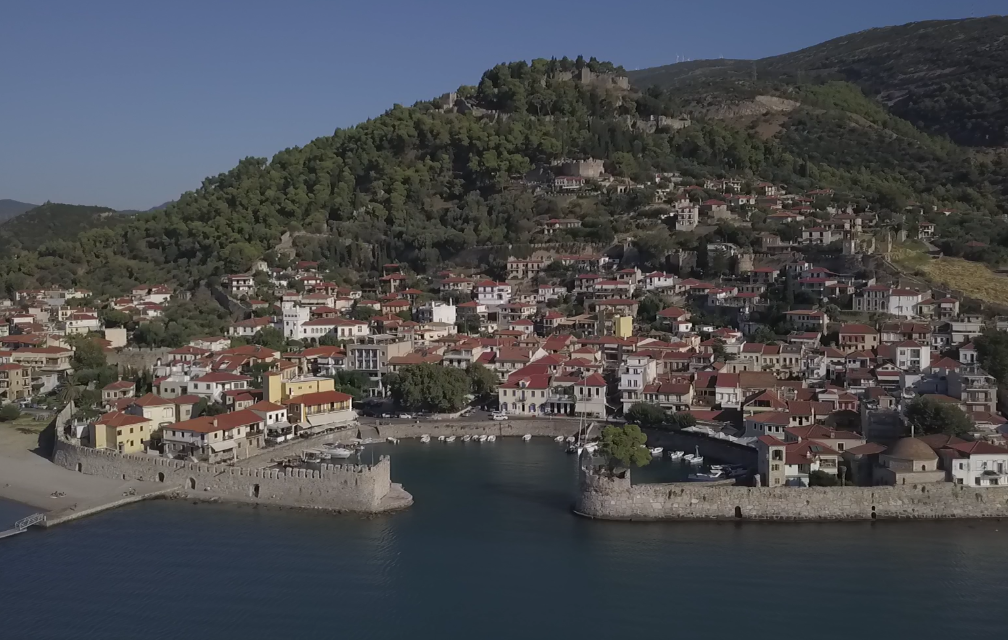
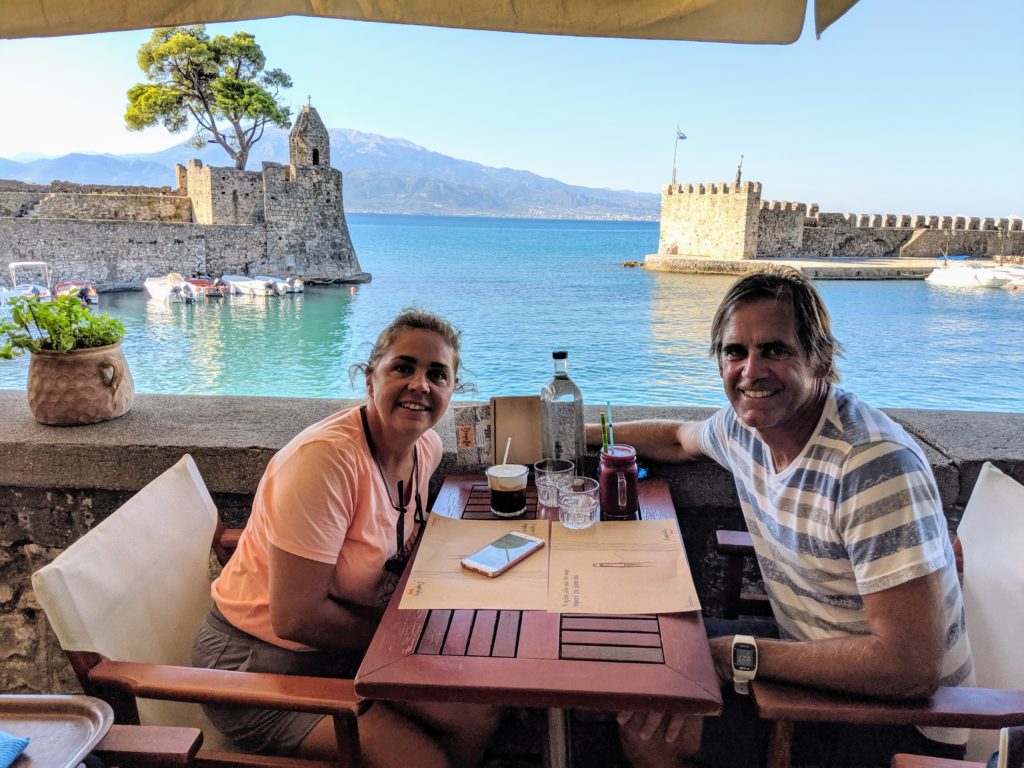
As we climb the hill on the way out of the harbor center, we stop first at the Lepanto clock tower, then the ruins of an Ottoman bath, in need of more signage at a minimum and preferably a lot more restoration, and finally to the castello at the crest of the hill, affording us ideal views of the town and the Gulf in the distance.

But even a historical gem like this must be time-boxed, as we try to keep to a rough arrival date at the Corinth Canal at the other end of the Gulf later this week. We find a great little market with small amounts of everything we need – why we can’t have move of these simple yet fully stocked stores in the USA instead of the 20 aisles of madness and grocery cart gymnastics is beyond me. With our loot stowed away in the holds of Sea Rose, we have the anchor up and the bow pointed East again on a wind-less day to the island of Trizonia along the north shore. These small towns were consistently recommended by other sailors in these waters. Sticking to the northerly side was the general strategy, and so far we found the recommendations on the mark. Inside the harbor at Trizonia, we had the unusual pleasure of side-tying to an actual dock, a rarity in the Med. Here was a multiple-piered marina that hadn’t quite made it to the grand opening. The concrete surfaces were rough and unfinished, requiring us to double up on our use of fenders. There was limited if any water or electricity, which was less of a concern to us now with our new watermaker. Still, a young well-dressed man arrived on a mountain bike in the afternoon requesting payment. Never sure of who is in charge of what around here, we decided to not balk at the dockage fee of 8 euros. It felt like you could count the population of this island on one hand, so if this guy was an imposter, it didn’t seem consequential.
After spending many of the last few days onboard, it felt good to get a long walk in on the well maintained dirt path around the perimeter of the island, taking in more sweeping views of the Gulf of Corinth – and wondering as we passed a few parcels of land for sale how much it would cost for year-round access to these sights! Small olive orchards – some well cared for, others left to go wild – reminded me of the golden hills of Northern California.
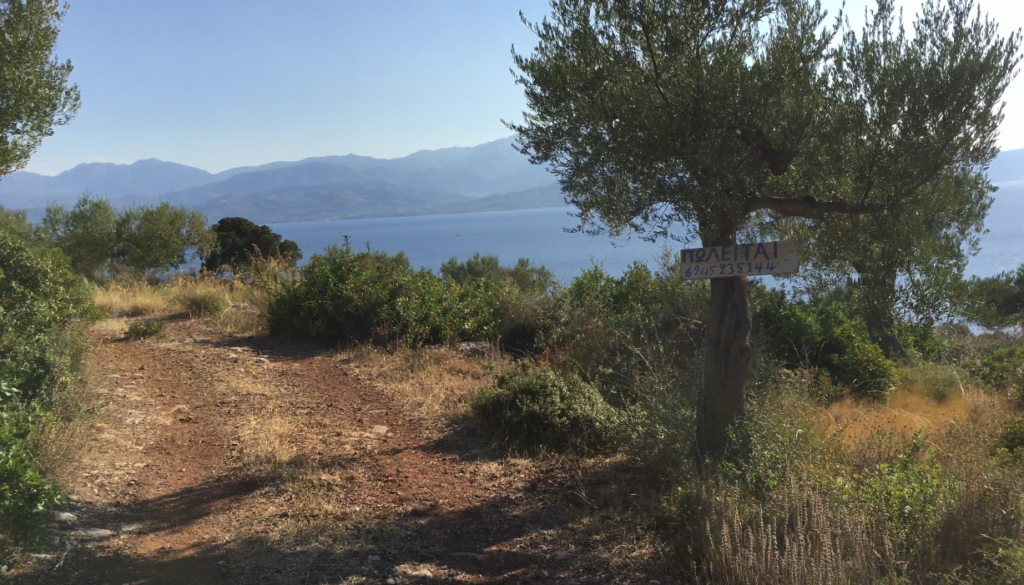
A small commercial harbor existed on the side of Trizonia facing the mainland, and here the hum of the village was easily felt. Needing a little hydration after our hike, we settled into a couple of cafe chairs and ordered a liter of chilled white wine, the specifics on grape varietal and branding of no importance. Two waterfront dining experiences in one day – this Greek tourism thing was working for us!
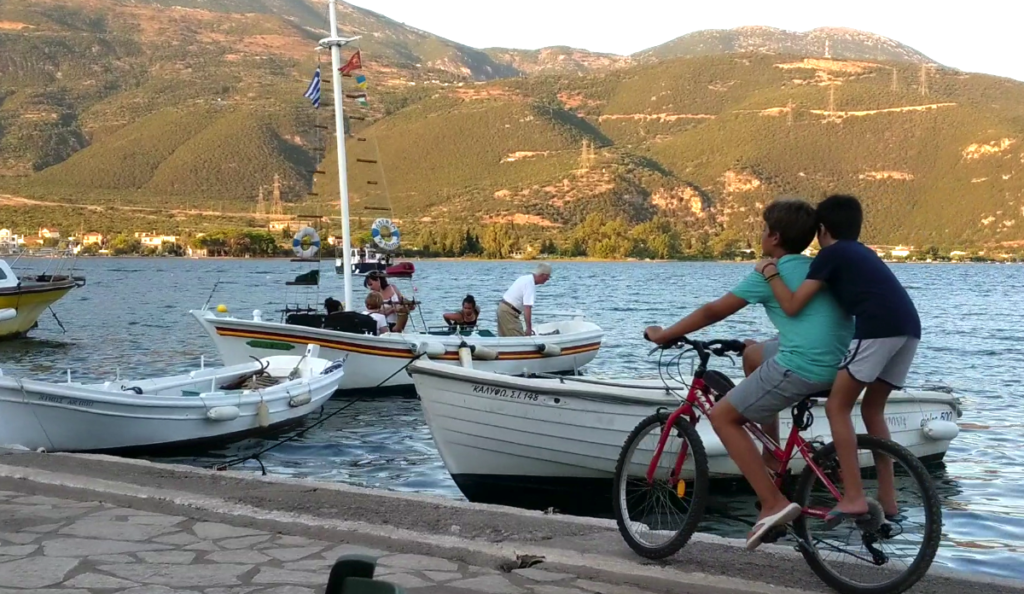
On our hop-scotch exploration of the northern shore, we drop our dock lines early the next morning for the 20 mile stretch to Galaxidi. We had been told this was an attractive town in and of itself, but also a good jumping off spot to tour the ancient ruins at Delphi up in the foothills. We motor on another windless day pas\t motionless windmills on the shore, juxtapositional with an old lighthouse – old and new technology in one frame.
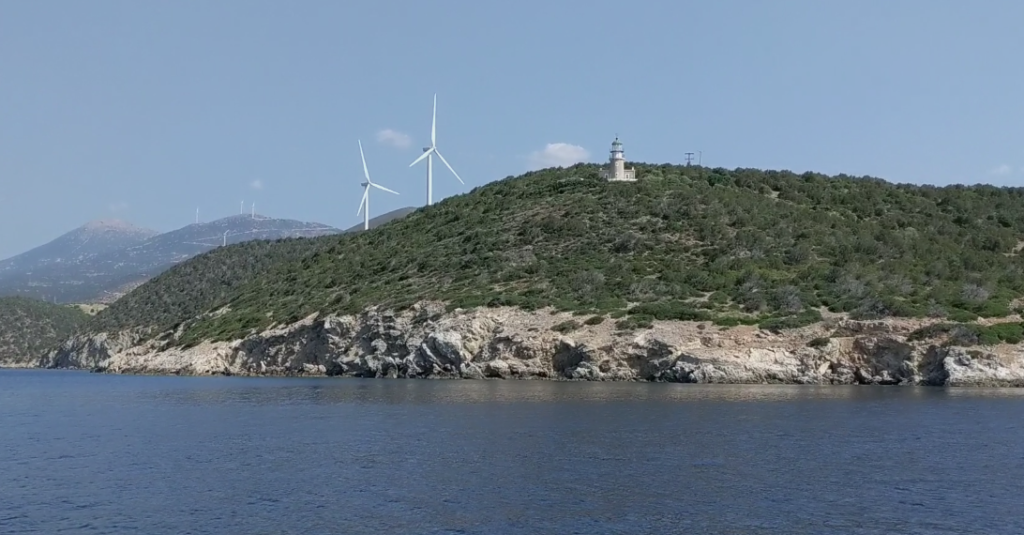
The wind rises briefly so we can refresh our sailing skills, before dying again as we entered the harbor of Galaxidi. There is ample room here to anchor and still enjoy fine views of the prominent cathedral peaking out above the rest of the buildings on the town’s centrally located hillock. We are not the first boaters to think of renting a car here to take to Delphi, as an enterprising person has already positioned a dozen cars at the waterfront advertising their rental car worthiness. We secure a clean, white VW Polo for tomorrow morning for the single-vendor-in-town price of 40 euros, and then head for another good healthy walk around town, finding many old sea captain residences strategically marked with a maritime-themed address marker tile.
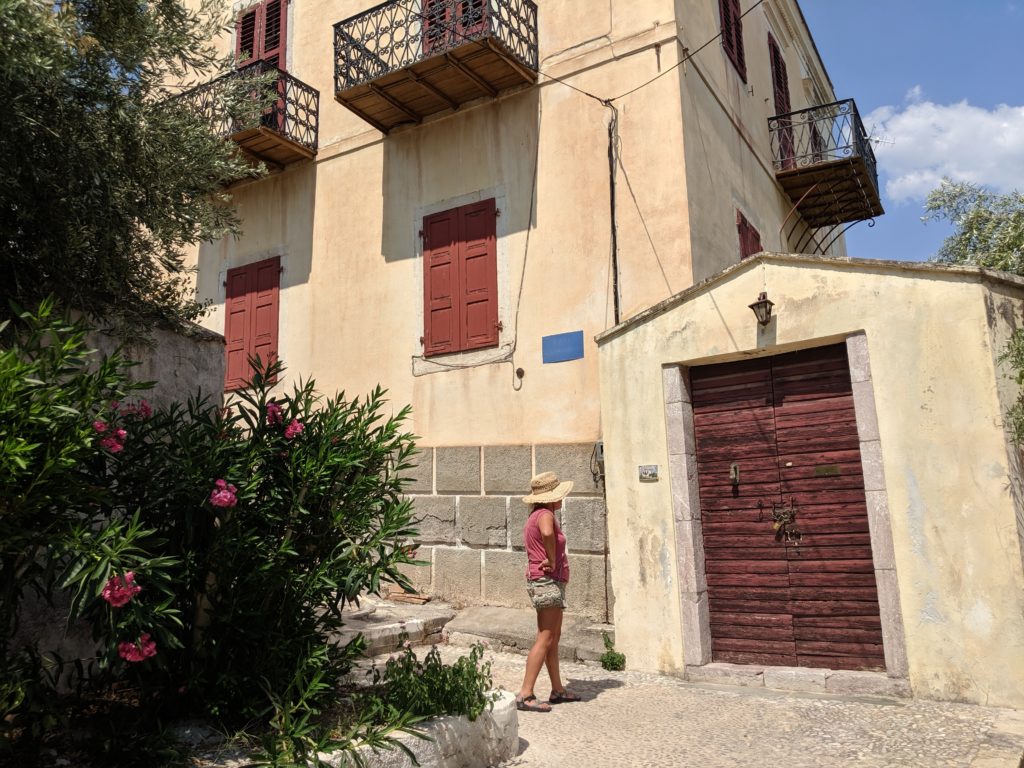

Back aboard Sea Rose, we settle into a gusty evening as the winds build to 15-20 knots – a forecast we expected but still put us on guard for the swinging and dragging of other boats. Thankfully it was an uneventful overnight, and we dinghy ashore at first light to start our adventure to Delphi. It starts unceremoniously, as I pull on the rear door handle to stow our daypacks and find I have superman strength as the handle completely separates from the door! Hopefully Mr. Monopoly Car Rental Man will understand.
We were told to get to the entrance of Delphi early to avoid the bus loads of people, and we are one of the first to pay at the turnstile at 8:30am. The early morning sun casts long shadows on the windy path above us as we started our discovery of this UNESCO World Heritage Site. The ancient Greeks considered Delphi to be the center of the world. With no accommodations to stay overnight here, this was strictly a sanctuary, and the purported home of the oracle, used to consult on the important decisions of the day. For my part, the only oracle I knew about was a very wealthy database company in California, but perhaps I should have paid more attention back in mythology class. Still, the peace and symbolism of this place, high up in the mountains overlooking the sea, could not be denied. Apparently, the heads of neighboring settlements would regularly journey up here to bestow opulent gifts upon the gods, hoping to win their favor. This could explain why there appeared to be so little pillage of the ruins, with no one wanting to tempt the fires of hell. What was missing in the present day seemed mostly due to normal weather and aging.
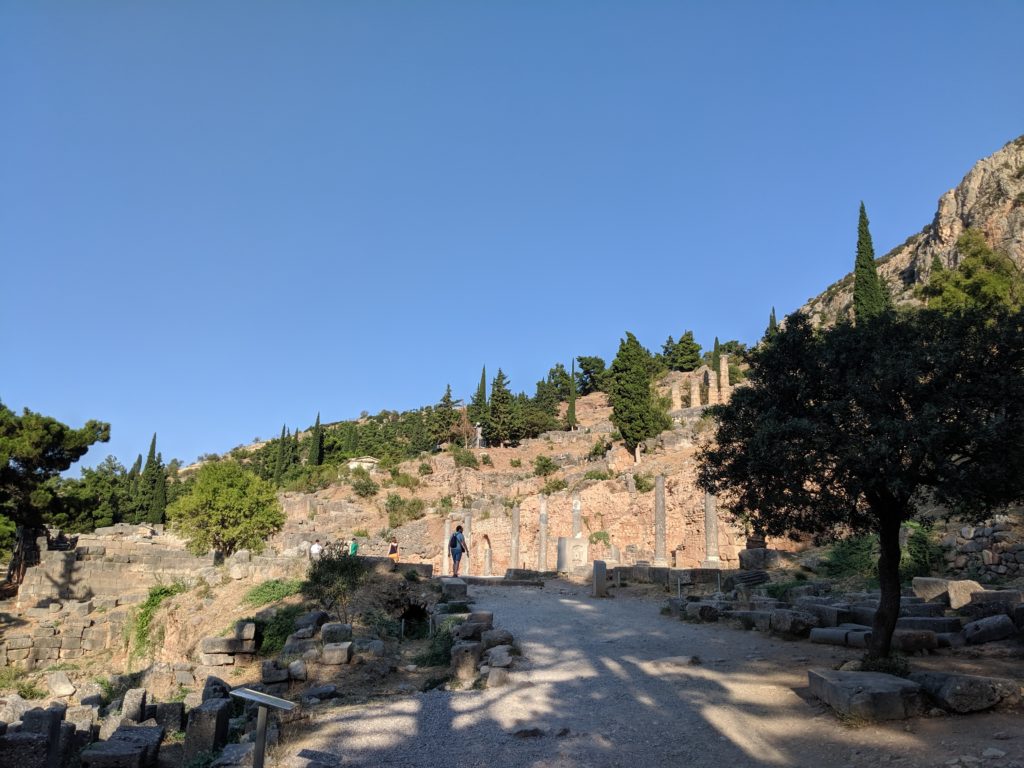
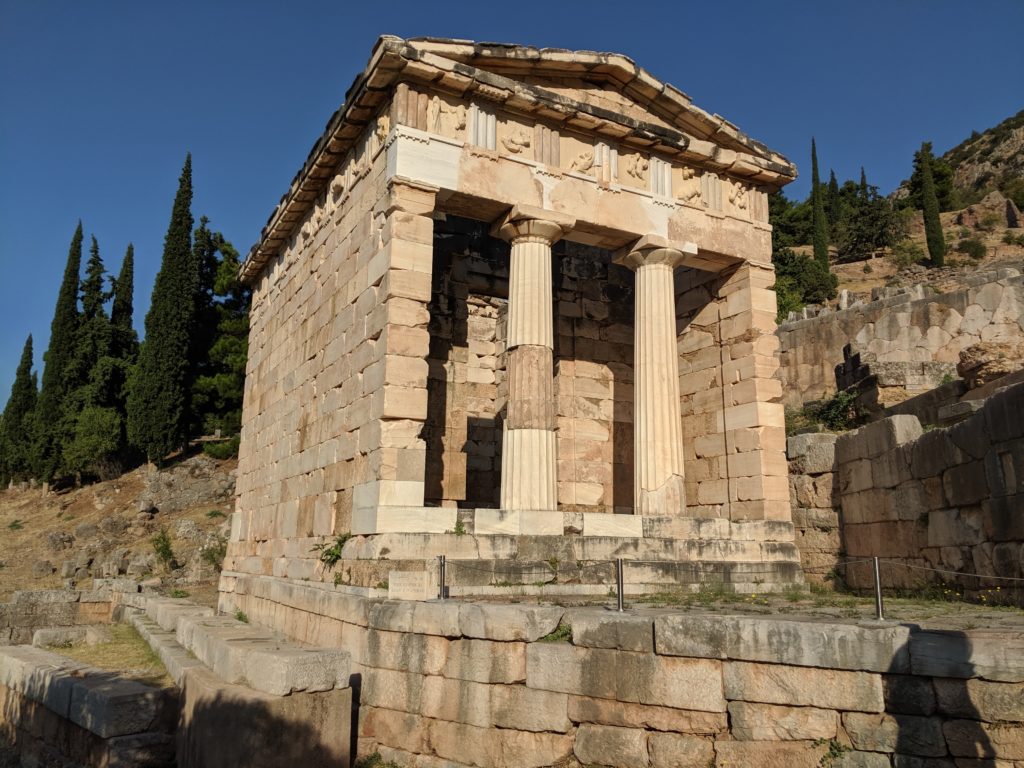
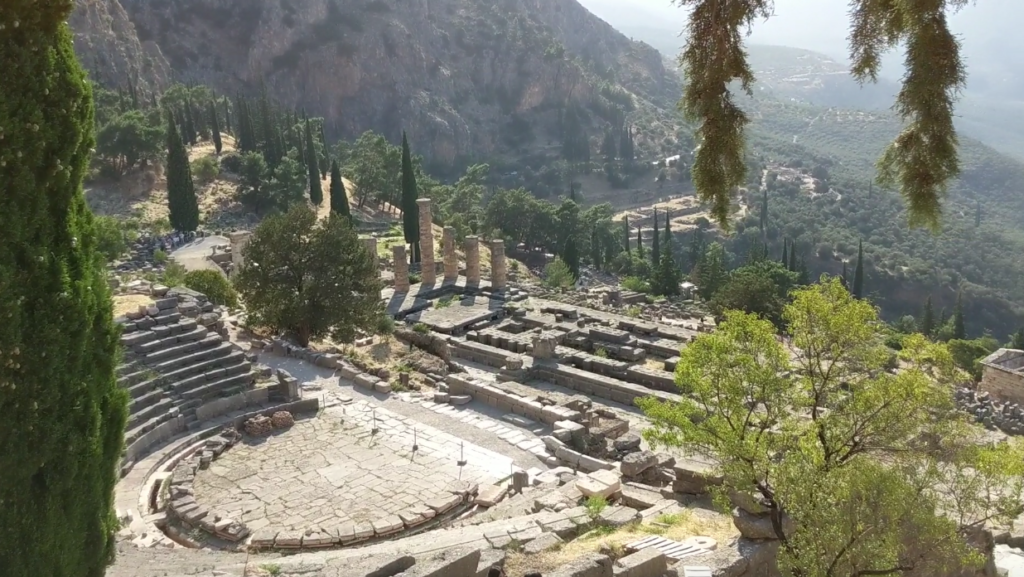
After a few hours and a marked increase in tour bus arrivals, it was time for us to drive our door-handle-less Polo onward. With a full day’s rental, we decided to continue up the mountain side further, arriving soon after at the ski village of Arachova. Yes, that is right, I said ‘ski’ village. We could still look in the distance to the Gulf of Corinth on whose waters our able craft floated on the sea, but here was the village that served the ski slopes of Mount Parnassus. Dark wood trim siding, not unlike the style of a high alpine Swiss village, graced the hotels and ski apparel shops here, just 90 minutes from the sea. It was all too much to believe, forcing us to buy some ski village souvenirs lest we forget.

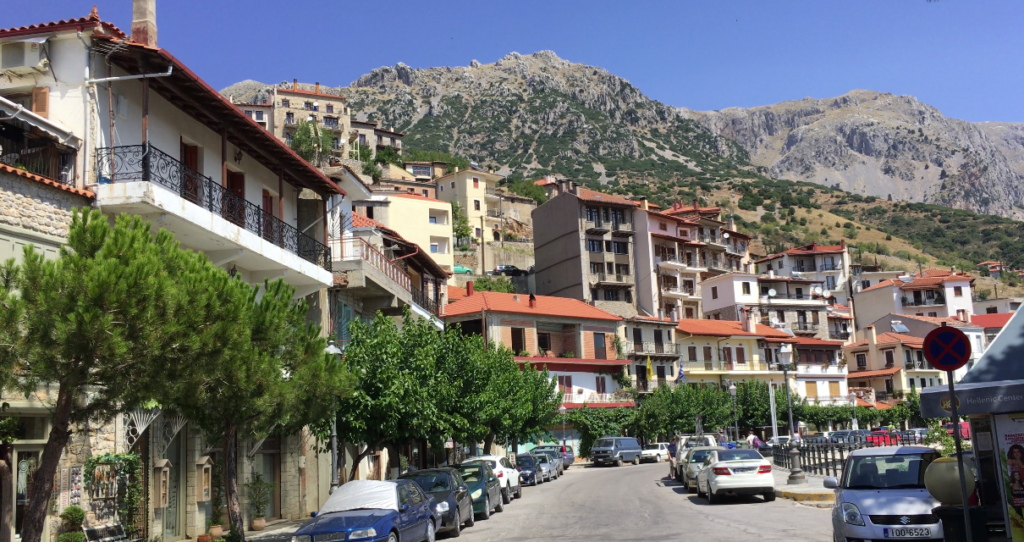
It’s a long drive back down to Galaxidi and to our boat. Forecasted high winds have subsided and Sea Rose is bobbing in the aftermath of light swells. Karen and I are a bit anxious about crossing the Gulf to the canal entrance, so we decide to get a few miles under the keel before nightfall. We turn off the motor when a light wind grows from abeam, and we are sailing gently along in a bit of sloppy seas. The winds are shy and shifty though, never a good sign. Soon they build strength from the port beam. Looking closer, I can see white caps approaching, and quick-as-a-finger-snap we are surrounded by 25 knots. Water is spraying horizontally into the side of our cockpit. It gusts to 30 knots and we begin to reconsider our plans to continue, with the Gulf only getting more exposed further ahead of us. We furl sails and I change course towards a small cove along the shore directly upwind of us, while suiting up in full foul weather gear and lifejackets. It starts gusting to 40. We had heard some tales about these sudden wind storms, as temperature shifts late in the day cause cool air to descend from the mountain tops that lace the shoreline, and accelerate as they fall towards the sea. Locally they are called katabatic winds, originating from the Greek word ‘katabatos’, meaning ‘descending’. This seemed like our baptism by fire to this peculiar weather phenomenon. The small cove ahead of us has a few long-slung buildings that could be a fisherman’s camp but is otherwise empty and desolate. The land from the mountain peaks slopes slowly down to the cove and it is not hard to envision these temperature-gradient winds blasting us ceaselessly all night with nothing but perfecting curved barren land to funnel them right at us. And who knows if the bottom conditions would allow our anchor to even hold in these conditions. With big boulders thrown willy-nilly on the shore, we could just as easily get our tried-and-true anchor stuck in a rock crevasse, never to rise to the surface again. The last straw was our chart plotters, suddenly unresponsive, for what reason it wasn’t clear – perhaps the coating of salt building up from the sea spray, perhaps the overloading of its processor as sensors were pounding it with bits and bytes. The right decision was now clear. We turned 180 degrees around and headed back towards Galaxidi. As we did, the boat accelerated to over 8 knots, as the tail winds pushed us and the dinghy, normally hanging on its davits, tightly against the stern railing of the cockpit. Salty water was being carried horizontally into the cockpit, covering us, cushions, deck and lines in a thick coating of white salt crystals as it dried in the warm temperatures.
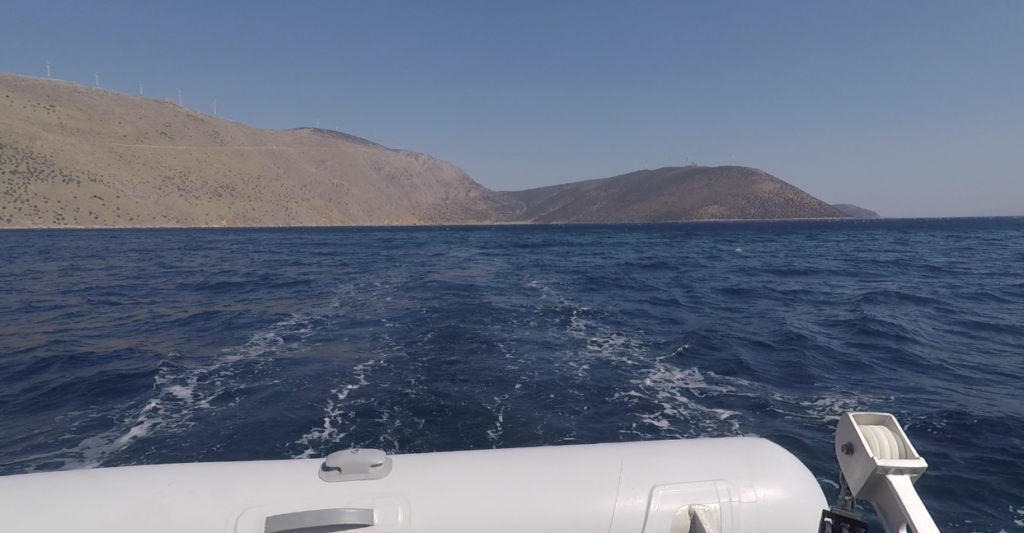
Soon, we are in a zone of calming 10 knots of winds. Then, just 5 knots. This is crazy! We are left to continue motoring, and arrive back at our same trusty anchorage spot in the Galaxidi harbor. The water is flat calm, not even enough wind to snuff out the barbecue of pork chops for dinner. Once again, we shake our heads in disbelief about how Mother Nature works in mysterious ways. We turn in early for bed, with plans to try again early tomorrow morning.
When you’ve got momentum, it’s tough to force yourself to stop, let alone go backwards. But that can be the wisest decision. Years ago, when I was training for what would eventually be my first marathon, I developed serious pain in my left knee. After a dreary report from my doctor, I gave up on running and searched without success for a silver lining in my declining physical and mental health. Six months later, with fancy new shoes and the support of my running friends, I was back out on the road. What I needed most was rest.
In Galaxidi, we didn’t need six months, but it sure felt good to recuperate from the katabatic winds of yesterday. We were ready to go at 4am to get a jump start on crossing the Gulf of Corinth before forecasted high winds arrive late morning. We had seen several fish buoys yesterday, and it is very helpful to have our GPS track line to follow from yesterday to avoid these hazards in the pitch-black, pre-dawn conditions. I can feel the stress coming on again as we pass our turnaround point from yesterday and the water opens up beyond Cape Pangalos, where the northerly wind has many more miles of fetch to pound us with short steep waves. As the sun rises, the wind comes along for the ride, and we raise double-reefed sails. Surprisingly, Sea Rose handles the large seas beyond the Cape with grace, as we charge ahead at 7-7.5 knots in the 30 knot winds.
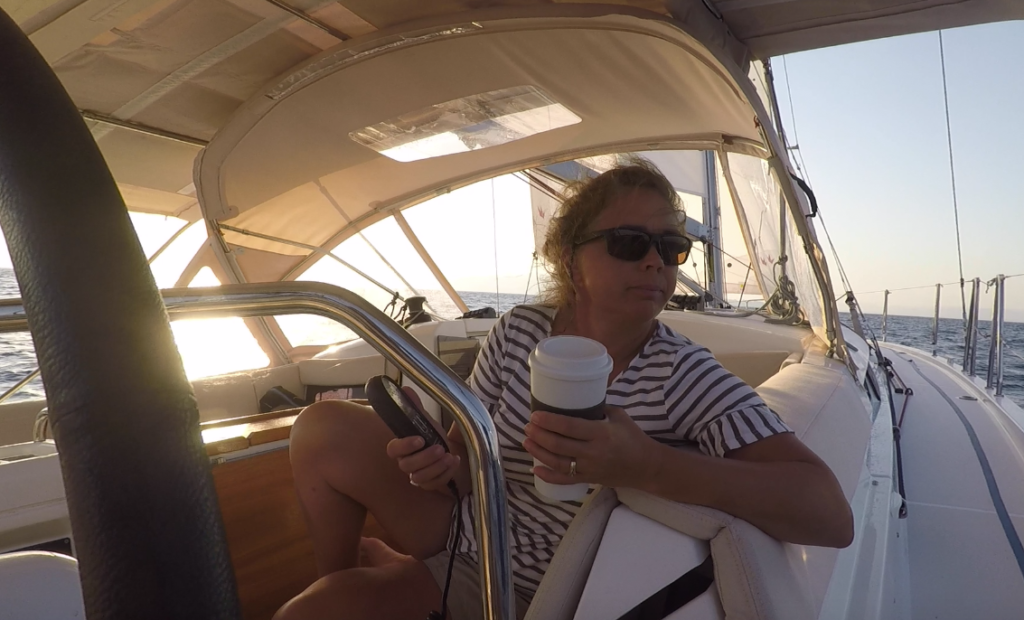
Our goal is to get close enough to the Corinth Canal entrance that we can either stop for the night or transit through. As we approach the stunningly rugged Cape Melangavi, and the protection of its high headlands, we lose the wind but gain the peace of flat water.

We can see the canal entrance in the hazy distance, and several other sail and power boats converging for pole position. For every story we had heard from other sailors about the beauty of the Gulf of Corinth and Patras, we had heard an equal number of being battered and scarred. We saw both sides of it and were elated to be moving forward again, ready to transit the canal and cross the threshold to the Aegean Sea.

